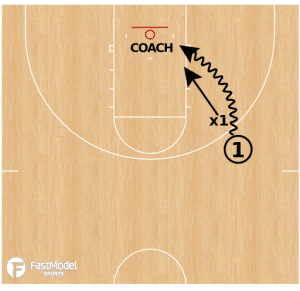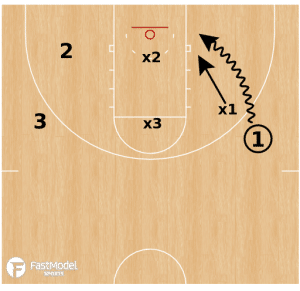
This post was adapted from a post made in the Fast Model Drills and Plays Library by John Leonzo, Assistant Women’s Basketball Coach at Cedarville University.
You can see the orignial post at this link: Blind 1 on 1..
You can also find out more about FastModel Play Diagramming software by clicking this link: FastDraw
As with any drill that you see anywhere, you should adjust it to fit what you are looking to teach and improve before installing it.
I like the idea of drilling a lot of one on one (both in-season and during the improvement season) but only with the purpose of applying it in a team offensive concept.
That is what was appealing to me about this setup.
the drill starts 1 on 1 and then builds to 3 on 3.
You can move the starting position and move where the 2nd and 3rd offensive players and defenders are positioned to make it fit what you see in your games.
I also think it is a good idea to add a scoring and or timing component to the drill.

x1 is facing the hoop with their heels on the 3pt line.
As soon as 1 puts the ball on the floor, it turns into live 1v1.
Editor’s Note from Brian: You might not like this method of starting the drill. You could start it with a pass from the top of the key with the defense closing out on the receiver.

The second level now is to add a coach to the drill to be a guided help defender.
This is a great time to teach the drive to land on 2 feet so they are balanced, strong, and controlled as they meet the help.
Be sure to emphasize straight line drives and players will try to loop drive to avoid the help.
The diagrams’ offensive drives are not a good example of a straight drive, but are slightly arced to distinguish the offensive movement from the defensive movement.

The next progression is to 2v2.
It is now that you are teaching the driver to do 2 things:
1. Read the help defender (x2)
2. Score if the helper stays, giving the advantage to 2 if x2 steps to help on drive.
Editor’s Note from Brian I also think this is a good time to emphasize driving to put the ball in the basket, and not on contorting and getting off balance to draw a foul. Driving to draw a foul leaves the decision up to the official and I don’t consider that to be a smart play. You might not get the call you want or the defender might be able to avoid contact.

The last progression is to take it to 3v3. The same reads apply for the driver on the attack, but now you are also training 2 to keep or increase the advantage.
If x2 stops ball and 1 passes to 2, 2 then has to keep the advantage. 2 can accomplish this by:
1. If he is open, on balance, and in range – shoot the ball
2. If x3 stays home and x2 recovers hard, 2 can drive the ball
3. If x3 drops to help, 2 keeps the advantage by hitting 3 with a “click pass” (a pass that is in and out of the passers hand within a half second or less). 3 then shoot if open, drives a hard closeout, and makes a pass.






